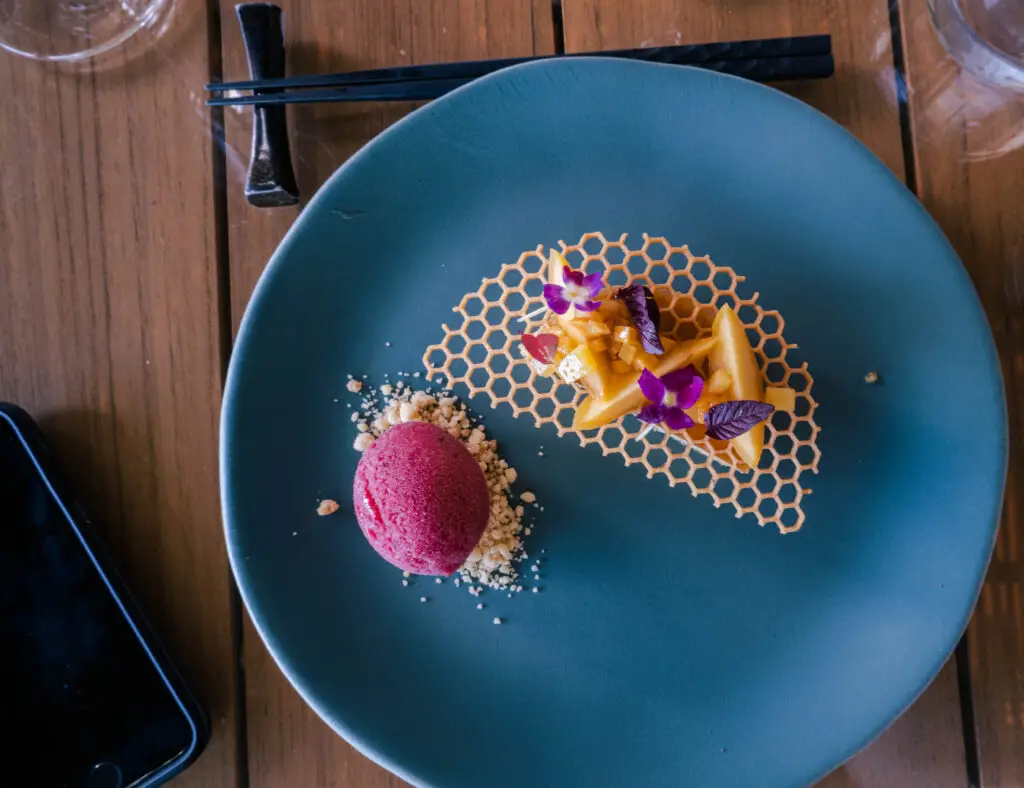Part Three: Hoseki Wonderland
Hoseki Wonderland R2200 per person for the tasting menu After an hour’s drive from Cape Town into Stellenbosch, we finally arrive at the Delaire Graff Estate with its famous cheetah statues carved by artist Dylan Lewis. The initial beauty of the surrounding nature was punctuated by the well appointed decor of the entrance. We were welcomed into the restaurant, our eyes immediately arrested to the soaring origami chandelier, and then sat outside on the terrace to a peaceful and expansive view. Our waiter Justine took us through the menu, explaining all the concepts, before we enjoyed some sparkling wine, spicy edamame and various tsukemono. We did not try the tasting menu at Hoseki but decided to go a la carte, ordering small plates individually to get an understanding of the food. From salmon rolls to shrimp tempura, the available cuisine was expansive, another beautiful combination of South African and Japanese cuisine. We were given housemade soy sauce, so light and savoury that we were drinking it out of our dishes. One dish ordered was the salmon rolls, which came with rice, salmon, roe, sesame, and green onions all laid upon a bed of nori seaweed that you wrapped yourself. The roll was fresh, the nori crunchy, with each ingredient complimenting each other. Two scallop dishes were ordered, a skewered scallop assortment, and a grilled dish. The skewered dish came with more fish roe, in addition to a citrus butter. The grilled scallops came topped with small pieces of mandarin, with garnishes of chives and a peppery salsa. Each dish was unique in its own right, the butter enhancing the softness of the scallop; we made sure to leave every plate empty. Two highlights of the meal were a wagyu open sando (sandwich), and a dish of ostrich tartare. The open sandwich came with three strips of grilled bread, adorned with cape wagyu beef and fish roe. The crunchiness of the bread, the softness of the meat and pops of the roe all combined to be a magical explosion of flavour in a small bite. The other highlight was ostrich tartare, set upon a rolled Japanese omelette called ‘tamagoyaki’. But that wasn’t the whole dish – there were thin slices of crispy bread, in addition to a can of fish roe, this time more like caviar (our waitress emphasised that while the can contained what for all purposes was caviar, the eggs were not technically caviar). The combination of all these ingredients may have made this dish the best out of all three restaurants. It was crunchy, salty, and savoury; the egg and soy sauce adding unparalleled umami. It was a dish that we will remember for quite some time. A classic Japanese dish was another that we decided to give a try. Karaage, Japanese fried chicken, is a staple in Japanese restaurants, and in Japan in general. You’ll find it on street corners, or being sold at a stall during a festival. The crunchy, salty, citrus-y flavour is hard to find outside of Japan, save for Hōseki. Stacked high in a beautiful Japanese bowl, the chicken came with grated daikon and lime, with a dipping sauce on the side. As the meal came to an end, we gave a variety of desserts a try. First off was a ‘sata andagi’, a traditional Okinawan style donut. With yuzu miso ice cream and a delicious dipping sauce, this dessert was uniquely scrumptious. Next was a sweetiepie and raspberry sorbet. Topped with fresh fruit and a biscuit lattice, the plating may have been one of the prettiest of this entire meal. The sorbet was atop a light crumble, which added a complementary crunch to the ice cream, similar to the lattice on top of the cake. We also indulged in a green tea cheesecake with chocolate ice cream, a stunning combination of traditional Japanese matcha tea. The tea had a slight bitterness to it, which paired perfectly with the rich chocolate crust and sweet ice cream. With the meal winding down, we had a cup of green tea and coffee, and took in the views of Stellenbosch once more. With a satisfied grin, we expressed our thanks to the chef and staff, and left the restaurant.
Part Three: Hoseki Wonderland Read More »

